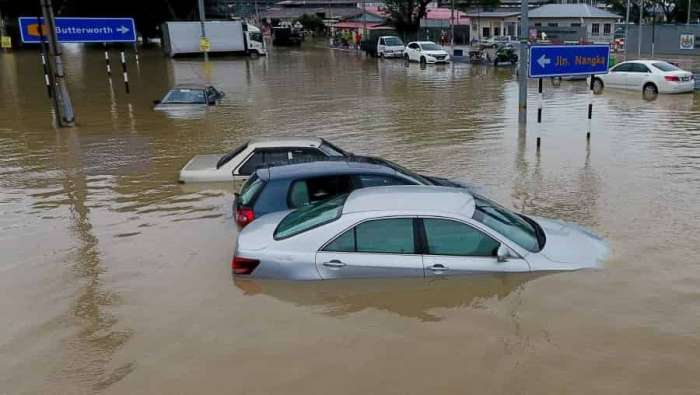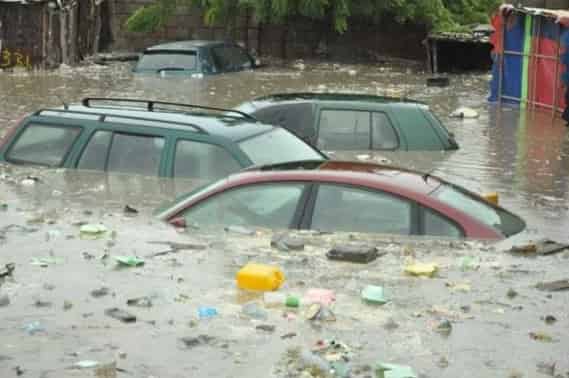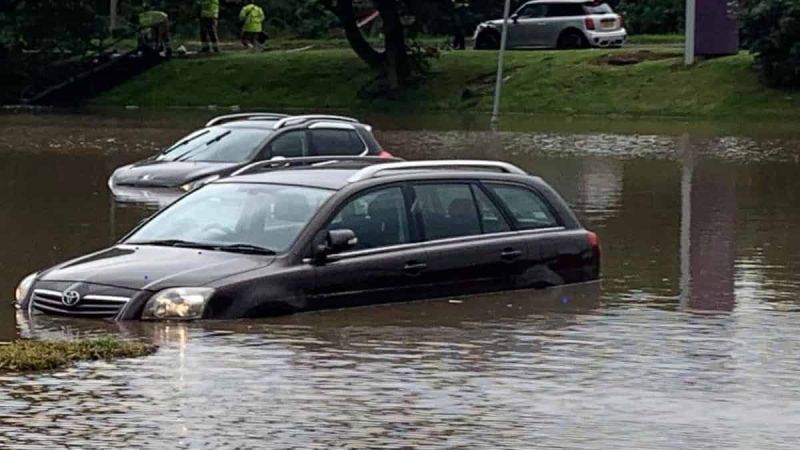If you were watching the "Weather Channel" this week, you probably saw that major vehicle makers were the victims of torrential rainstorms. The Metro Detroit area received a deluge of rain over the weekend, and the South became more waterlogged. The far Northern states received round after round of heavy thunderstorms.
Precipitation News Far From Good
For the auto industry, this precipitation news was far from good. Stellantis reported that many newly manufactured Jeeps were up to their windows following the torrential downpours that roared through the Detroit Metro area during the weekend.
As reported by reporter Mary Conway, Jeep dealers are starting to receive shipments of Grand Cherokee L SUVs. Owners have been patiently waiting.
Likely, Stellantis was not the only automaker that had parts of its inventory submerged following the rainstorms. Ford and GM likely found some of their inventory in the same condition Monday morning. It is the type of turn that the automakers didn't need as they have watched the demand for their new product skyrocket.
Unfortunately, for many vehicles that had just rolled off the lines at Stellantis or Ford, or GM, the vehicles should be tossed unless there are parts that must be recovered. For example, while it might be possible that body panels can be dried and reused with suitable paint and coating prep. It probably isn't a good idea for a couple of reasons. First, there may be weird chemicals in the water that, when they dry out, may be detrimental to your health or the vehicle itself. In other words, the water may hold chemicals that inhibit the electrophoresis paint process and primers and later coats.
These parts may indeed have already been prepped, coated, and painted, but, after sitting in standing water with who knows what might floating past, it is probably a good idea to scrap the vehicle. (It is a great time for Ford as I reported recently and now nature may be raining a bit on its parade.
To prevent wholesale scrappage, manufacturers could try to clean things up and make them reusable by using other heavy chemicals. It isn't likely to be successful because floodwater – even flash floods of freshwater caused by heavy rain – will pick up chemicals from the soil and deposit those added chemicals on the surface of body panels or the frame.
Water poses major problems for while heat is another key problem is heat. Heat can be fatal to children and pets.
Torque News Doesn't Know Total Cost
Torque News doesn't know how much inventory was rain-spoiled, but you have to figure it is substantial. Indeed, the irony of the situation is that just when assembly lines are cranking up a bit to make added inventory, automakers have found that many of the high and dry vehicles last week are now underwater.
You might wonder what would happen if an automaker tried to take one of the finished vehicles for reuse after a dip in the floods. Would it be successful? After all, in 2021, you would think that the auto industry can do wonders with drying and reusing submerged vehicles. This isn't the case at all.
The continuing rains that have been beating on the Midwest, South, and Metro Detroit highlight a problem with the summer monsoon season but the West's continuing heat shows why it may be a great idea to have a Toyota Hybrid.
Let's take a vehicle like that might have been only partially drowned in a flash flood through no fault of its own. You might think that the saving grace would be that the vehicle was submerged in freshwater. However, as noted, with soil and tarmac contamination and tarmac, the vehicle would be exposed to who knows what chemicals.
Electric vehicles are coming on fast as is shown by a piece by Senior Reporter John Goreham. An EV may just be the ticket for a vehicle caught in a downpour.
Since the submerged vehicles had rolled off the assembly lines and were awaiting shipment to either customers or dealers, there is bound to be some lost business for automakers. Like the chip shortage that has and continues to cause slowdowns and loss of business for automakers like Ford and Stellantis, and GM, the ongoing deluges do nothing to help the inventory situation. Indeed, Ford and Stellantis have been hit hard by the chip shortage and are only very slowly beginning to recover. Total recovery won't occur until early 2022, and any inventory lost now for whatever reason hurts. It is also inventory that is gone.
As we have noted, you might think that given today's technology, an automaker would be able to take a submerged vehicle, clean it up, and reuse it. However, that isn't the case. Aside from the chemical stew that we have already noted, there's the simple fact that some of these vehicles have been underwater for days. This means that rust and other nastiness have begun to eat away at vehicles from the inside. That's why we noted that it is likely that any submerged vehicles should be tossed.
One state's new noise law may require vehicles with loud exhaust notes to be tossed as well. My colleague Jimmy Dinsmore looks at the noise law closely.
Is A Vehicle Recoverable
Let's look at what an automaker would have to do to try to recover a vehicle. As noted, someone might try to reuse a vehicle by doing a cleanup. What would that entail? For starters, if the rain had dunked the vehicle to its windows, the entire interior would have to be junked. That means the seats and upholstery would have to be trashed. Then, the headliner would have to go, as would the door panels and the carpets. The water has had a chance to do its damage, so the pieces are unusable. You might think that an automaker would only have to take all the interior panels out and lay them out in a drying room. You would think that the seats and upholstery could also be taken out and left in a drying room, as would the headliner. This would be possible if there is a drying room available.
Unfortunately, exposure to water makes the interior materials vulnerable to the residue left by the chemical stew. There are naturally occurring nasties like mold. Indeed, mold would be a continuing worry because once it starts in a moist environment, it is usually impossible to root out no matter how long vehicle parts are in drying rooms.

Then, there's the vehicle itself. Like we just noted, mold enters many small spaces, and once there, it never gets out. Indeed, the wiring of a flash flood vehicle stands a good chance of rotting, and if it doesn't rot, it might become mold-infested.
Any electronic parts of the vehicle would need replacement because they can't be dried out quickly enough. It would take some weeks to dry the electronic and semiconductor parts enough to be useful.
Then, of course, mechanical parts like the exhaust, the manifold, the engine and driveline, the brakes, tires, wheels, and the lighting need replacement. Once they are in floodwater for any appreciable time, they are essentially useless. As you can see, even though the floodwater is fresh, it can wreak havoc on a vehicle.
An Example Of What Water Can Do
Here's a perfect example of what water can do to a vehicle (it is a true story; the dealership and location are hidden for privacy). About 20 years ago, a dealership bought what it thought was a good, new high-line vehicle from another dealership in a different part of the country. Once the vehicle arrived on the sales lot, something didn't seem right as one of the service advisers noted an off odor that he couldn't place.
They put the rather expensive vehicle up on a lift and brought the dealership photographer to look at the vehicle and document any damage. The photographer began examining the vehicle's underside and noted that above the transmission, a layer of mud-like dirt caked up. Moving along under the vehicle, the photographer found more dirt and traced its path. It turned out that all of the wheel wells were also caked with dirt. And, when the photographer tried to spin the wheels – which should have been freewheeling – all he could hear was grinding and rocks within the wheel. There was also mud on the back of each tire.
On lowering the vehicle, they found dirt well up on the engine. They also found that the seats had been reupholstered, leaving the original seat upholstery intact underneath (this was where the odor originated).
The entire vehicle was a fraud. The dealership quickly canceled the sale, and the wire transfer never went through. They ordered a ramp truck to pick up the offending vehicle and return it to the original vendor. The dealership saved on the order of $38,000 for the luxury vehicle.
Submerged Vehicles Particularly Worrisome
That would be the case with any submerged vehicle that had faced a torrential downpour. The reason things are particularly worrisome with these vehicles is simple: they have been underwater for more than a day. From the look of recent news reports coming out of the Detroit Metro area, vehicles have been underwater for a couple of days.

What would happen, though, if some fly-by-night car reclamation firm were to come along and pickup vehicles that might have escaped? Indeed, it has happened, especially if the vehicle might be a late-model sitting on a used-car lot. Many times, these vehicles aren't tossed. Instead, a fly-by-nighter will come in and pay a small dealer or individual cents on the dollar to get the vehicle out of the area.
When this happens, a multi-car carrier quickly appears. Any submerged are hustled out of an area to a spot where they are superficially dried out and detailed. Of course, this type of operation depends on quick turnover. It also depends on folks who want something for very little.
The sleazy operators get folks on the hook by selling through Craigslist or eBay or another service where the pedigree of a vehicle isn't questioned. The only thing that matters is the cost and how much a person might save.
Buyers seldom notice problems with flood car specials until it is too late. Their money has been transferred. It is gone. The sleazy operator is several states away, likely operating under a new business name while bilking others who want deals on low-cost, late-model vehicles.
Water Can Cause These Problems
What happens next is that the poor buyer is stuck with a vehicle that may have odors. It will also likely operate poorly if it operates at all. The buyer will likely take this great deal to a mechanic who will likely go through the vehicle and then hand the buyer an estimate in the four to five figures to get it roadable.
Like as not the problems include:
- Engine problems
- Exhaust problems
- Manifold problems
- Driveshaft problems
- Half-shaft problems (front-drive)
- Transfer case problems
- Rear-end problems
- Brake problems
- Odor/Mold problems
- Upholstery problems
- Major electrical failuires
- Wiring problems
- Brake problems
- Wheel/Tire problems
If this looks like the vehicle is a complete basket case, the chances are that it is. So, the buyer's great deal turns from the deal-of-the-decade into the mess of the decade. Not only is the buyer out the money paid to the con artist, but they will likely be out the money needed to make the vehicle right if that is possible.
In the case of a flood vehicle, there is very little you can do to make it right. The vehicle, which was such a "sweet deal," will have to be tossed.
Indeed, this is what you have to watch out for with vehicles that have taken a swim in torrents left by thunderstorms.
Marc Stern has been an automotive writer since 1971 when an otherwise normal news editor said, "You're our new car editor," and dumped about 27 pounds of auto stuff on my desk. I was in heaven as I have been a gearhead from my early days. As a teen, I spent the usual number of misspent hours hanging out at gas stations Shell and Texaco (a big thing in my youth) and working on cars. From there on, it was a straight line to my first column for the paper, "You Auto Know," an enterprise that I handled faithfully for 32 years. Not too many people know that I also handled computer documentation for a good part of my living while writing YAN. My best writing, though, was always in cars. My work has appeared in venues including Popular Mechanics, Mechanix Illustrated, AutoWeek, SuperStock, Trailer Life, Old Cars Weekly, Special Interest Autos, and others. You can follow me on: Twitter or Facebook.












